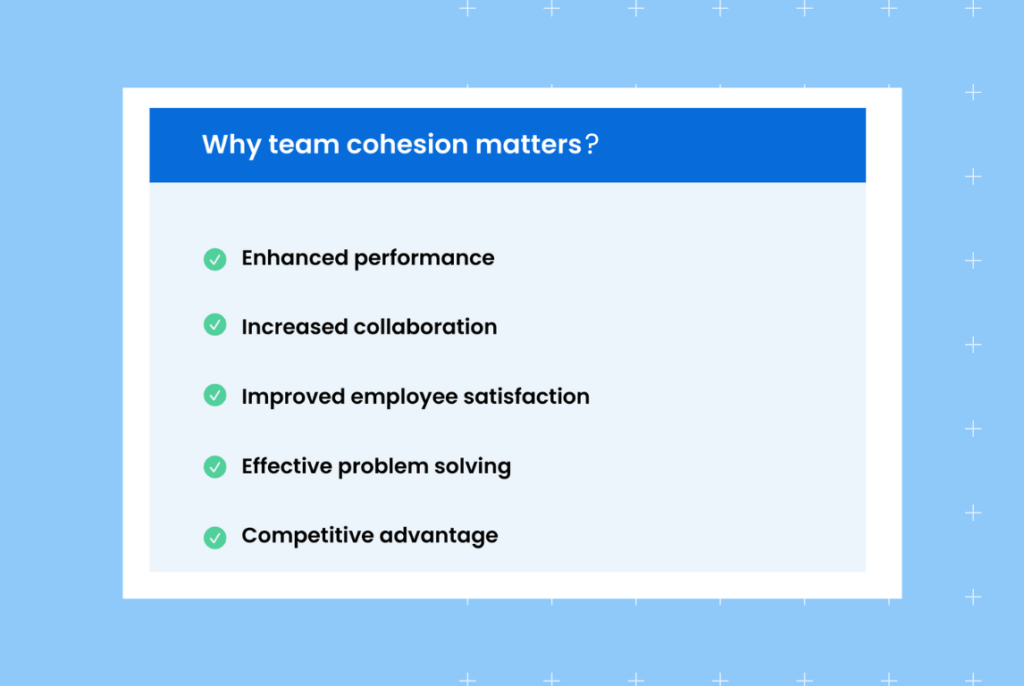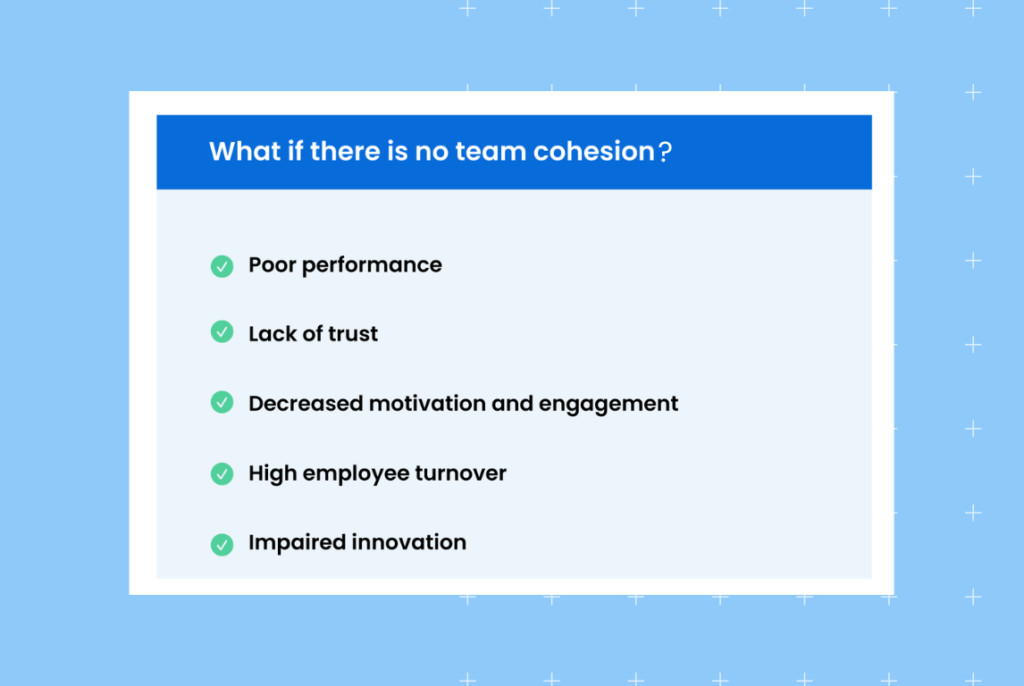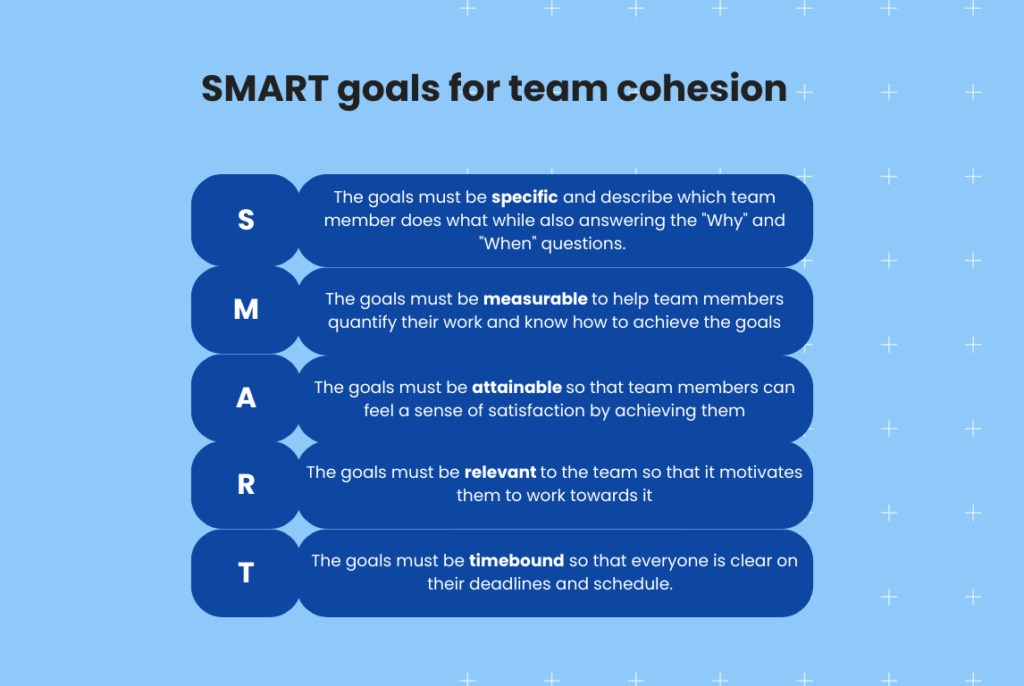Any business’s success depends on how well the team works together. Building team cohesion and having them strive towards a common goal results in customer satisfaction, increase in revenue, and a faster growth curve for your business.
But a team is often made up of people from different backgrounds with different interests. It is important that every local business owner invests in team cohesion to grow their business.
This blog post deals with everything you need to know about building a cohesive team.
Birdeye – all-in-one platform
Automate Reviews, Ratings, Listings & Reputation Management with Birdeye.
Table of contents
What is team cohesion?
Team cohesion is a metric that shows whether the members of a team can work together to achieve a common business goal.
Mutual feelings of trust, loyalty, and commitment between team members bind them together and promote collaboration.
You can build team cohesion with common goals, acceptance, and support. It can be developed over time with a consistent effort from each member in order to build an atmosphere of trust, cooperation, respect, communication, and collaboration.

Why is building team cohesion important?
Building team cohesion is important because it can motivate team members to work together more effectively and efficiently. It also encourages creative problem-solving and idea-sharing, which leads to better results.
Here are some more reasons why team cohesiveness among all your employees matters:
- Enhanced performance
- Increased collaboration
- Improved employee satisfaction
- Effective problem solving
- Gaining competitive advantage

Enhanced performance
When there’s high cohesion among team members, it creates an environment that promotes team development and mutual respect. And guess what? This leads to better communication, cooperation, and coordination.
People in a cohesive team are more likely to share information, resources, and expertise. This, in turn, creates a supportive environment that improves productivity, leading to improved business results.
Increased collaboration
When team members feel a strong sense of social cohesion, they develop a greater level of assurance and understanding among each other. This sense of collaboration encourages collective participation and discussion, leading to better ideas and solutions. Since team members are more willing to collaborate and work together to overcome challenges, they will be inspired to seek new ideas and innovative solutions.

Improved employee satisfaction
Team members within a cohesive team are likely to feel a sense of belonging, acceptance, and support from their colleagues. This positive social connection leads to increased job satisfaction. It also boosts a more favorable company culture that supports higher levels of employee engagement. And when you succeed at creating a cohesive group, complete with effective communication channels, reduced conflicts, and clear roles, you can expect a decrease in employee turnover and better overall retention.
Effective problem-solving
Team cohesion creates an environment that encourages open and honest communication. Everyone can have a say and point out ideas. When you achieve such levels of cohesiveness, team members can freely share ideas, unique perspectives, and experience-based insights when handling challenging situations.
Team cohesiveness leverages the group’s diverse skills to create a broader range of creative solutions. Conflicts are also managed constructively, serving as opportunities for learning and growth.
Gaining competitive advantage
A cohesive team works together to leverage each member’s strengths and expertise, which is a huge asset when it comes to competitive advantage. When your group is a streamlined efficiency machine, it means you’re more adaptable and open to innovation.
When there are clear communication channels and everyone understands each other, team members can adapt quickly to market changes and address the evolving needs of customers. Team cohesion acts as a catalyst for improved efficiency and collaboration, which gives any company a significant competitive advantage in the marketplace.
What are the negative impacts of not building team cohesion?
When there’s a lack of team cohesion, it’s gonna impact the output of the team. There will be decreased productivity as each group member operates independently fulfilling individual results instead of the team goals. Here are some other negative impacts of a lack of team cohesion.
Without team cohesion, businesses suffer from:
- Poor performance
- Lack of trust
- Decreased motivation and engagement
- High employee turnover
- Impaired innovation

Poor performance
Teams that lack cohesion often suffer from a breakdown in communication causing a barrier to collaboration. This absence of unity and shared purpose causes team members to struggle to work together effectively. It can also result in conflicts and poor project coordination.
Ultimately, a lack of cohesion results in an unmotivated and disengaged staff. You’ll then see a poorer quality of work which can negatively impact the business’s bottom line.
Lack of trust
When a team lacks cohesion, the members are hesitant to trust the abilities and intentions of their colleagues. Information might be withheld or perceived to be withheld. Without trust, communication strains and relationships begin to crumble.
You’ll also recognize that members will hesitate to share ideas or take on responsibilities. People tend to become more self-focused, fostering competition among the ranks rather than collaboration.
Decreased motivation and engagement
When team cohesion is low, members tend to feel disconnected and lack a sense of camaraderie. This often leads to a situation where they become disassociated from the team goals. Members are going to struggle to find personal or professional fulfillment in their work, too, since they don’t share ideas or contribute their full potential. When they don’t feel heard, valued, or collaborative, they’re just going to unplug.
High employee turnover
When there is a lack of cohesion, where team members feel disconnected, unsupported, and undervalued, you can expect turnover to happen. This deep-rooted dissatisfaction at work ultimately drives employees to seek opportunities elsewhere.
Team members need to feel supported to build strong interpersonal relationships. Without those relationships, decreased motivation and low morale can creep in, hurting the company culture. This can also lead to disruption of workflow in the workspace.
Impaired innovation
A lack of team cohesion can negatively affect innovation as well. Team members are going to be far more cautious about sharing ideas, taking risks, or collaborating on innovative solutions when they’re feeling disconnected from the group or the problem-solving process. This stifles creativity and limits the exploration of new ideas. Without trust and open communication, team members are less likely to engage in constructive debates leading to missed opportunities.
How to build team cohesion : Top 8 ways
The impact of team cohesion in the workplace is undeniable. But without a clear strategy for fostering a more connected and unified team, the goal of a cohesive environment can seem like an elusive one.
Experts believe that businesses should take the following steps to build and boost team cohesion:
- Develop shared goals
- Define team values
- Support effective communication
- Invest in team-building activities to build trust
- Build a recognition and reward program
- Celebrate success as a team
- Build strong leadership
- Offer cohesive training and development
Develop shared goals
It’s mission-critical for a team to have shared goals. Set a clear understanding of the shared objectives and their roles in achieving them. Shared goals foster a sense of unity, purpose, and collective responsibility.
This strengthens group cohesion but also fuels growth. By emphasizing the importance of these goals, we establish a framework for allocating tasks and evaluating performance, which in turn promotes accountability and commitment.
Define team values
Building team cohesion becomes easy when the team has a shared purpose and shared values. In addition to shared goals, it is important that you explain your company’s mission statement and values so that they can work with the same principles at play.
When the team comes together, talk to them about what the company’s overarching values are – this can be excellence in customer service, faster delivery, getting a higher volume of positive reviews, and so on.
Support effective communication
When team members promote open, honest, and frequent communication, they build trust, understanding, and a shared sense of purpose. Plus, clear and transparent communication helps to eliminate misunderstandings and boosts employee engagement. It’s also the best way to resolve conflicts.
Invest in team-building activities to build trust
Team building activities offer a chance for staff to connect and bond outside of regular work tasks. By engaging in fun activities, people can build mutual respect, forge stronger relationships, and boost team spirit. These activities encourage open communication, problem-solving, and cooperation, enabling individuals to discover and leverage each other’s strengths for effective team collaboration.
Build a recognition and reward program
When team members feel appreciated through recognition and awards for their contributions, it creates a supportive and positive environment. Recognizing both individual and collective achievements is a good way to boost team morale. Regularly celebrating these milestones is also a great way to bring people together and encourage them to continue striving for excellence.
Celebrate success as a team
To build cohesive teams, it is important that they feel a strong sense of comradery when projects go well or when a customer appreciates the business. If one person gets the spotlight more than the other, this may not bode well for teamwork.
Celebrating successes as a team makes everyone feel equally important and also demonstrates the value of teamwork in achieving success. Now you can be sure that they will work well together when it is time for the next big project.
Strong leadership
A great team leader is all about providing guidance, direction, and support to build team cohesion. They don’t just talk the talk, they walk the walk and set the perfect example for their team. Trust, respect, accountability, and collaboration are the building blocks of their culture. They empower and inspire their team to bring out the best in themselves.
Offer cohesive training and development
A team that grows together is more likely to stay together. Do not underestimate the power of training and development in building a cohesive team. Offering team-wise training and development means you upskill the whole team together and also bring them closer than before.
How to set goals to build team cohesion
Goal setting with and for your teams is necessary to establish specific objectives as well as desired outcomes. These goals are designed to create a sense of shared purpose and promote a unified team culture. Here are some tips to consider when setting goals to enhance team cohesion:
- Identify common objectives
- Set SMART goals
- Involved team members in goal setting
- Create a roadmap
- Include regular check-ins
- Work on continuous feedback and adjustments
Identify common objectives
When team members share common objectives, it aligns their efforts toward mutual success. It lets them establish a collective vision and direction. Team members who share common objectives are also going to be more likely to communicate better, support each other, and collaborate to achieve those common goals.
Set SMART goals
Using the SMART (specific, measurable, achievable, relevant, time-bound) framework for goal-setting ensures teams can set clear, well-defined goals that provide direction and purpose. Clear, trackable, realistic, relevant, and time-specific goals drive pinpoint precision on outcomes that reinforce cohesion. SMART goals have proven to improve productivity and overall team performance.

Involve team members
It’s crucial to involve team members during the goal-setting process. This helps foster a sense of ownership and commitment to their achievement. Don’t just set the bar for them, invite them to contribute to the decisions about where and why to set the bar.
By actively involving members, you bring in diverse perspectives, experiences, and expertise. This leads to more comprehensive and relevant goals – you know, the kind that truly makes a difference.
Create a roadmap
As you would with any other team-driven business strategy, consider creating a roadmap for you and everyone to follow. Developing a roadmap helps team members understand how they will achieve their goals.
A well-defined roadmap also clearly marks the steps, milestones, and timelines necessary to attain the desired outcome. It also helps effectively track and measure progress enabling the team to stay focused and motivated.
Regular check-ins
As a team leader, you should schedule regular check-ins with all of your employees to monitor their progress. Check-ins provide an opportunity for group members to share updates, and address any challenges or concerns. Consistent communication via regular check-ins helps a team stay connected, aligned, and motivated, strengthening team cohesion.
Continuous feedback and adjustment
Feedback is the engine that drives a team and its members to success. By providing ongoing feedback team members understand their strengths, areas of improvement, and their contributions to the team’s goals. Team members can learn from their experiences, make adjustments, and grow together through continuous feedback loops.
FAQs about team cohesion
Examples of team cohesion can be demonstrated through trust-building activities, collaboration and support, mutual accountability, conflict resolution, and cohesive decision-making.
The main characteristics of a cohesive team include trust, clear communication, shared goals, collaboration, and mutual support.
You can demonstrate team cohesion by actively engaging in behaviors that promote unity, collaboration, and a strong sense of collective teamwork.
Cohesion is essential for teamwork because it directly impacts team effectiveness, productivity, performance, culture, and overall success.
Build team cohesion with Birdeye Messaging
Team cohesion is undoubtedly the secret sauce necessary for the success of any team. It increases productivity and improves problem-solving while creating a more positive working environment.
Birdeye Messaging makes it easy to engage with team members. It puts all conversations in one place so that every member understands the full scope of your projects. Click the banner below to learn more.

Originally published


![this is a 1 / 1 – [Feature image] of the blog about 31 irresistible car sales email templates to close more deals.](https://birdeye.com/blog/wp-content/uploads/Feature-image-31-irresistible-car-sales-email-templates-to-close-more-deals-375x195.jpg)
![[Feature image] Are you on these 40+ powerful eCommerce review sites blog](https://birdeye.com/blog/wp-content/uploads/Feature-image-Are-you-on-these-40-powerful-eCommerce-review-sites_-375x195.jpg)